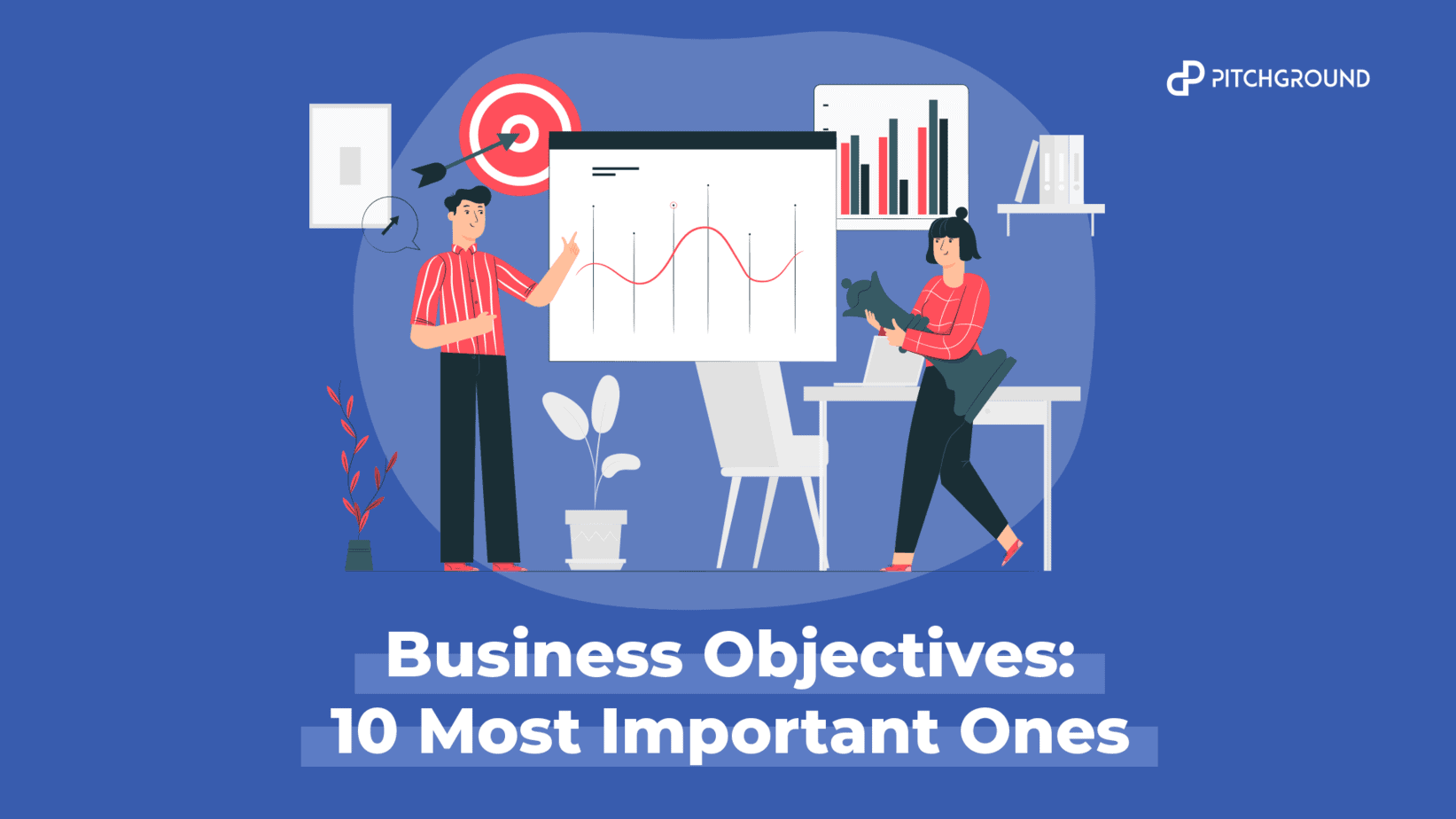When starting a new business, it’s essential to set goals. But how do you know whether you’ve achieved your objectives?
To achieve success, you must first define what success looks like. It will help you determine whether you’re achieving your goals.
This article will share 10 common business objectives that every startup should strive to achieve. I’ll also explain why these are important and how you can measure them.
What is a business objective?
Business objectives are defined as goals that businesses set out to achieve. They are usually written down and shared with employees; in other words, a business objective is an action plan that describes what needs to happen to reach a goal.
For example, a company may want to sell more products than last year. It would be a business objective. It would include things such as increasing sales by 10 percent every month.
It means that each employee has a job to do to help the company achieve its goal. An employee may be responsible for selling one product. Another employee may be responsible for another product.
In this case, the first employee would be responsible for increasing sales by 10% per month. The second employee would then be responsible for increasing sales in their area. These two employees would work together to achieve the overall goal.
When setting up a business objective, it is important to define the following:
• What does the business want to accomplish?
• How much money will it generate?
• Who will benefit from achieving the goal?
• Why should anyone care about the goal?
• What resources will be required to achieve the goal?
• How will the goal be measured?
• What steps must be taken to achieve the goal? These steps could include hiring additional staff, training existing staff, etc.
Once these questions have been answered, the next step is to write them down.
It helps everyone involved understand their role in achieving the goal. It also makes it easier to measure progress towards the goal.
Types of business objectives

Financial Business Objectives:
Businesses are always trying to maximize profits, but sometimes they forget about other types of financial goals. For example, businesses might want to minimize costs, save money, or generate revenue. These are all examples of financial business objectives.
To achieve these goals, you can try different tactics. One tactic is to look into outsourcing services. Outsourcing allows companies to focus on running their business while letting someone else handle specific tasks.
Another option is to consider hiring freelancers to work on projects. Both options allow you to cut down on overhead expenses and free up resources for other areas of your company.
In addition to financial objectives, you can also set nonfinancial objectives. Nonfinancial objectives include customer satisfaction, brand awareness, and employee morale.
When setting nonfinancial goals, it’s important to remember that they aren’t as tangible as financial ones. However, they still play an integral role in your business.
For example, if you run a restaurant, you could set a goal of increasing sales. But the methods you use to reach that goal would differ.
It would be a financial objective, whereas improving customer service would be a nonfinancial objective. In both cases, you’d be working towards achieving the same thing—increasing sales.
The bottom line? Set your financial and non-financial business objectives, then figure out how to meet them.
Customer-centric Business Objectives
Businesses today must focus on customer satisfaction and engagement if they hope to succeed.
The best way to achieve this goal is through customer-centricity. Customer-centricity refers to the idea that businesses should always put customers first. It means that every decision made by a company should be based on whether it benefits its customers or not.
It doesn’t just apply to companies that sell products online; it applies to all types of businesses.
For example, a restaurant could choose to offer free meals to customers who spend over $10 per month. Or a hotel might give discounts to guests who book rooms for multiple nights.
These examples illustrate how customer-centricity can benefit both consumers and businesses.
When businesses act in a customer-centered manner, they create loyal customers who are willing to recommend them to others. And these recommendations can lead to increased sales.
In addition to benefiting customers, customer-centricity has other benefits for businesses.
One is that it helps companies avoid lawsuits. Another is that it allows them to attract talented employees. Finally, it can help companies build strong relationships with their clients.
Internal Business Objectives
Businesses have different types of goals depending on their industry and size. Some businesses focus primarily on making money, while others aim to provide value to customers.
Regardless of the type of business you run, you should always strive to achieve internal business objectives.
Internal business objectives include increasing revenue, reducing costs, improving customer service, and developing employees.
These are all fundamental aspects of running a successful company, and if you aren’t focused on these areas, you might be missing out on opportunities to grow your business.
To help you reach your internal business objectives, consider implementing a strategy that focuses on three main areas: sales, operations, and marketing. Each area has its own set of metrics that you can track to determine whether or not you’re meeting your goals.
For example, you could measure sales performance by tracking the number of leads generated each month, revenue earned from each sale, and the total profit generated.
Operations can be measured by tracking inventory levels, employee productivity, and other factors.
Marketing can be measured by tracking the number of visitors to your website, the number of emails sent, and the number of phone calls received.
By focusing on these three areas, you can easily monitor your progress towards achieving your internal business objectives.
Regulation Related Business Objectives
Businesses must comply with various regulations, including health and safety laws, environmental protection laws, and employment laws.
These laws can affect your company in many ways, from ensuring employees receive proper training to ensuring that products meet specific standards.
It’s important to understand these laws and regulations to avoid penalties and fines. It’s also essential to know what types of businesses fall under each law.
For example, companies that manufacture food products must follow strict guidelines regarding food safety. Companies that sell alcohol must adhere to specific rules regarding age verification and advertising restrictions.
There are several different types of regulation-related business objectives, including:
• Food Safety Regulations – These include requirements related to sanitation, labeling, and other aspects of food production.
• Environmental Protection Laws – These include regulations regarding water quality, air pollution, hazardous materials, and other issues.
• Employment Law – These include requirements related to employee benefits, wage and hour laws, and other topics.
• Health Care Reform – These include requirements related to healthcare insurance, medical records, and other topics.
List of Business Objectives You Should Know

Getting and Staying Profitable
One of the most important aspects of running a business is making sure that you’re profitable. It’s easy to become distracted from this goal if you aren’t careful, but it’s also essential to your long-term success.
To remain profitable, you need to focus on three main areas: increasing sales, reducing costs, and improving efficiency. These business goals can be achieved through effective planning and execution and help with financial growth.
Planning involves thinking about where you want to go and what you want to achieve. For example, if you’re going to increase sales, you might choose to create a business plan for creating a new product line or launching a new service. Once you’ve decided on these objectives, you need to break each into smaller tasks.
Execution means following through on your plans. When you set goals, it’s important to remember that you can’t always control everything that happens during the day. However, you can still manage your expectations and adjust accordingly.
For instance, if you’re having trouble selling a specific type of product, try offering discounts instead. Or, if you’re struggling to reduce costs, consider outsourcing some work. Either way, you’ll be able to adapt to changing circumstances and continue moving forward.
Productivity of People and Resources
It’s no secret that productivity is key to success. Whether you work for yourself or someone else, being productive is essential to achieving your goals.
When you’re working hard to achieve your business objectives, it’s easy to forget your personal needs. It’s important to remember that you can’t always expect others to pick up where you left off.
It means that you need to set aside time to focus on your health and well-being. Ensure that you’re taking care of yourself by eating healthy foods, exercising regularly, and sleeping enough. These habits will allow you to be more productive and focused during the day.
In addition, try to avoid multitasking. While it might seem like a quick fix, it actually takes a toll on your energy levels and concentration. Instead, focus on accomplishing one task at a time.
Once you finish that task, move on to the next one. Don’t worry if you miss a few tasks along the way; just make sure that you complete them eventually.
Excellent Customer Service
Customer service is one of the most important aspects of running a business. It’s no secret that customers expect excellent customer service from businesses, and if they don’t receive it, they’ll likely move on to another company or slash you with negative ratings.
To provide excellent customer service, you need to focus on building relationships with your clients.
Ensure that you respond to emails and phone calls promptly and always follow through on promises.
When someone has a problem with your products or services, try to resolve it as soon as possible. Remember, when customer ratings are high you’ll always have a huge inflow of new customers.
It’s also helpful to offer incentives to your clients. For example, you could give discounts or free shipping to loyal customers who refer others to your business.
The key objective here is to make sure that these offers aren’t too difficult to redeem. Otherwise, they might turn off potential customers and lead them to give you negative ratings.

Employee Attraction and Retention
Employee retention is crucial to business success. But what exactly does it entail? It’s much more than just keeping employees happy. Employee attraction and retention mean attracting and retaining the best talent possible.
To attract top talent, you need to offer competitive pay, flexible hours, and opportunities for advancement. You also have to have recruitment processes where you’re always scouting for new talents.
During the recruitment processes, you also need to look out for the soft skills that the employees exhibit. In order to properly assess them.
When it comes to retaining employees, you need to provide benefits, training, and development programs. These factors can help to create a work environment where employees feel valued and appreciated i.e employee satisfaction.
One of the most effective ways to retain employees is through employee recognition. Employee recognition doesn’t necessarily require money; it can simply be a thank you for a job well done.
For example, if someone has completed a project on time and under budget, give them a small gift card or certificate. Or, if someone has gone above and beyond, consider giving them a promotion or raise.
In addition to recognizing employees, it’s important to acknowledge customers. Whether you run a restaurant, sell products online, or operate a brick-and-mortar store, customer service is key to building loyalty.
Ensure that your staff members are friendly, helpful, and courteous to every customer who walks through your doors.
Remember, employee attraction and retention are only half the battle. The other part is making sure that your team is productive and efficient. To achieve these goals, you must have clear objectives and set measurable goals with the motivation of employees a vital need in the mix.
Mission-driven Core Values
Core values are an essential part of every business. Without them, you’d have no reason to exist.
Your core values are the foundation of everything that you do. They define who you are and what you stand for. They guide your decisions and actions and dictate how you interact with others.
It’s easy to lose sight of these values over time, primarily if you work in a fast-paced environment where priorities change frequently.
But having clear, consistent core values helps you maintain focus and avoid distractions. It also gives you a framework for making decisions and setting goals.
The core values not only empower you but also empowers the employee performance and their individual objectives in your company.
To create your own set of core values, ask yourself questions like: What do I believe in? Why am I doing this? How does this affect other people?
Once you’ve answered these questions, write down your answers. Then review them periodically to make sure that they still reflect who you are and what matters most to you.
Sustainable Growth
In today’s world, businesses must constantly adapt to changing market conditions. To survive and thrive, companies need to develop a strategy that allows them to grow sustainably over time. You have to set long-term goals in order to grow sustainably.
One of the most important aspects of sustainable growth is having a clear vision of where you want to end. It’s easy to lose sight of your goals if you aren’t regularly reviewing them.
For example, if you set a goal of increasing sales by 10% each quarter, you might miss your mark if you fail to adjust your plan accordingly.
It’s also important to consider whether your current business model is sustainable. Are you growing too fast, or does your company have room to expand without causing damage to its infrastructure? If you’re unsure, it’s best to consult with experts who can provide objective feedback.
Once you’ve determined your goals, it’s time to figure out how to achieve them. Start by identifying the key performance indicators (KPIs) that will allow you to measure progress toward your goals.
KPIs are metrics that indicate how close you are to reaching your objectives. This in turn helps your company growth.
For example, if you want to increase sales by 10%, you could look at the number of leads generated per month. Once you’ve figured out what KPI you wish to track, you’ll need to determine how to measure it.
There are many different ways to collect data, including surveys, interviews, and analytics software.
KPIs are measurable objectives and once you know how to measure your KPIs, you’ll need to decide how to interpret the information.
Do you want to compare your KPIs against industry averages? Or would you instead focus on reaching your KPIs to those from previous quarters?
The final step is to create a plan for achieving your goals. Make sure that your plan includes realistic deadlines and milestones. If you don’t meet your goals, you’ll need to revise your strategy and try again.
Maintaining a Healthy Cash Flow
One of the most important aspects of running a business is maintaining a healthy cash flow.
It’s easy to spend money without thinking about where it’s going, but if you want to avoid financial problems down the road, it’s important to pay attention to your finances. It means keeping a keen eye on your operating costs, production costs, and more.
It’s especially important to monitor your expenses closely during the holiday season. Many businesses experience a spike in sales during the holidays, but that doesn’t necessarily mean they can afford to overspend.
Make sure that you budget appropriately so that you don’t end up having to cut back on other areas of your business.
In addition to monitoring your spending, it’s also essential to track your revenue. When you can accurately predict your income, you can plan accordingly.
For example, if you’re expecting a large influx of customers, you can prepare for the extra workload by hiring additional employees or increasing your inventory.
Keep these tips in mind as you work toward building a solid cash flow.
Dealing with Change
Change is inevitable. Whether it’s a change in business objectives, a change in technology, or a change in your company culture, change will always happen. And while it’s important to embrace change, it’s equally important to prepare yourself for it.
Changes occur over a period of time and whatever time frame you are in you need to set strategic objectives to allow your company growth to happen.
There are three ways to deal with change: accept it, adapt it, or resist it. The best strategy depends on the type of change you’re dealing with.
For example, if you’re changing your business objectives, accepting it is probably the best option. However, if you’re changing technology, adapting to it is likely the best choice.
Regardless of the type of change coming, it’s essential to understand that change is never easy. It requires planning and preparation, and it can be stressful.
But it’s also necessary, and you can learn from others who have gone through similar situations.
So, whether you’re preparing for a significant change or just trying to figure out how to handle a small change, we hope that these tips will help you.
Reaching the Right Customers
Your business objectives are probably pretty straightforward—you want to sell products and services, right? But if you’re just starting, it can be hard to figure out exactly who your ideal customers are. Here’s where you need a solid customer strategy.
It is where demographics come into play. Demographics are data about a person’s age, gender, income level, education level, marital status, occupation, etc.
The more specific you can be about your demographic profile, the easier it will be to reach the right customers.
For example, let’s say you’re selling dog food. You could write a blog post targeting pet owners, but if you’re not sure whether your target market includes dogs or cats, you might reach too many people who aren’t interested in your product.
Instead, you could narrow down your focus by focusing on dog owners between the ages of 18 and 24.
It’s also helpful to consider your competition. What types of businesses are similar to yours? How much money do they generate? Where do they advertise? These questions can help you determine who your ideal customer is.
Next, think about your current customers. Who are they? Are they male or female? Do they tend to buy from certain stores? What kind of products do they purchase?
Once you know these details, you can create a strategy that targets your ideal customers. For example, if most of your customers are women over 40, you might decide to focus on advertising in magazines geared toward older women.
Don’t forget to include any special offers or discounts that you have available. It can be a great way to attract new customers and retain old ones. All-in-all including all of these in your customer strategy will help you land the best customers!

Staying Ahead of the Competition
Your business objectives are why you started your company in the first place. It’s important to understand these goals and how they relate to your customers.
For example, if your main objective is to sell products, you might focus on increasing sales. However, if your goal is to provide a service, you might focus more on customer satisfaction.
It’s also important to consider who your ideal customer is. Are they male or female? What age group does your perfect customer fall into? Do they have children? These questions can help you determine what type of messaging you should be sending to different groups of customers.
To reach the right customers, you need to know who they are and where they spend their time online. That’s why it’s important to track your visitors and analyze their behavior.
You can do this through analytics software, such as Google Analytics. Apart from that using the right business strategies can help you land the right customers.
Analytics software allows you to track visitor activity on your website, including where they came from, what pages they visited, and how long they spent on each page.
The data collected by analytics software helps you learn more about your customers and determine what types of messages work best for them.
Use this information to create targeted advertising campaigns that appeal to specific audiences.
For example, you could send emails to people who visited specific pages on your website. Or you could run ads on Facebook targeting people who visited your website.
SMART Goals
The SMART goals are the most common goals used in business. They are a simple, easy-to-understand, and used set of goals that can be used by anyone from any level of experience.
If you’re not familiar with the SMART goals, here’s a quick overview:
Specific – A specific goal must have a clear purpose and scope so that everyone knows exactly what they are working towards.
Measurable – A measurable goal must have a method of measuring success.
Attainable – If a goal seems too difficult to accomplish, then it probably isn’t attainable.
Relevant – A relevant goal should align with your overall business strategy and vision.
Timebound – A time-bound goal needs to have a deadline. Otherwise, it won’t be effective.
Frequently Asked Questions:
How to Create Effective Business Objectives
Your business objectives are your goals for yourself and your team. These goals are usually written down somewhere, whether on paper or digitally. However, if you're having trouble coming up with effective ones, here are a few tips to help you.
First, write down your top priorities. What are the most important things you need to accomplish over the next 12 months? Once you've figured these out, you can move on to the second part of creating practical business objectives.
Next, brainstorm ideas. Think about what you'd like to achieve, and then write down everything that comes to mind. Don't worry about making your ideas perfect—just jot them down and move on. Read through your notes and choose the best ideas when you're done. Now, you can organize them into categories based on what they relate to. For example, if you're trying to grow your company, you might create a "growth" category, while another could be labeled "marketing."
Finally, review your goals regularly. It's easy to lose sight of your goals when you're busy running your business, so it's important to revisit them from time to time. Reviewing your goals helps you stay focused and ensures that you're always moving towards your ultimate goal.
What’s the difference between accuracy and precision?
Accuracy refers to the degree to which a measurement reflects reality. Precision refers to the closeness of agreement among multiple sizes.
For example, if we measure a person's weight 10 times and each time the result is within 1 pound of the actual weight, we would say that our measurements were accurate. However, if we measured the same person 10 times and each result was off by 2 pounds, we would tell our measurements were precise.
How to build a strategic plan for your nonprofit?
Strategic planning is a crucial part of running a successful nonprofit organization. It helps you set goals, develops plans, and measure progress toward achieving them.
To create a strategic plan for your organization, you'll need to define your business objectives. These are the goals that you want to achieve through your work. For example, if you run a soup kitchen, your business objective might be to provide food for hungry families.
Next, you'll need to decide what resources you need to accomplish these goals. For instance, if you want to feed homeless families, you'll need money and volunteers. Once you know what you need to succeed, you can develop your strategy.
Your strategy is the roadmap that guides you toward accomplishing your business objectives. It includes specific tactics, timelines, and milestones to reach your goals. The best nonprofits follow a structured approach to strategic planning.
Your strategy is the roadmap that guides you toward accomplishing your business objectives. It includes specific tactics, timelines, and milestones to reach your goals. The best nonprofits follow a structured approach to strategic planning.
For example, you could break down your strategy into three phases. First, you'd establish your vision. Next, you'd outline your mission statement. Finally, you'd develop your values and ethics. Each phase has its purpose, building upon the previous ones.
In addition to setting clear goals, you'll also need to consider your budget. How much money do you have available? What kind of support do you have from donors? Will you need to raise funds yourself?
Once you've answered these questions, you can write your plan. Start with your vision, then move on to your mission and values statements. Then, add details about your strategies, timeline, and milestones.
You can present your plan to your board of directors and other stakeholders when you're ready. After you finish your plan, share it with others who can give feedback. Ask for their input and incorporate any changes that they suggest.
How to set and track stretch goals to inspire your team?
One of the most effective ways to motivate employees is by setting stretch goals. Stretch goals are specific targets that you set for yourself and your team members. When you reach these goals, you feel accomplished and motivated to continue working hard towards reaching higher levels of success.
Setting stretch goals is easy. Just create a goal that you'd love to achieve, then break down the steps necessary to get there. For example, if you want to write a book, you might say that you want to complete 500 pages. Then, you could break down each page into smaller chunks, such as 250 words per day.
Once you've reached your goal, celebrate your accomplishment by sharing it with others. It's always fun to share your accomplishments with friends and family, and doing so will boost your confidence and motivation. By creating a clear plan for achieving your goals, you'll be able to hold yourself accountable and give yourself a reason to work harder.
The Bottom Line:
In conclusion, if you’re looking to start your own business, here are ten important objectives you should have before you begin.
They include:
Getting and Staying Profitable
Productivity of People and Resources
Excellent Customer Service
Employee Attraction and Retention
Mission-driven Core Values
Sustainable Growth
Maintaining a Healthy Cash Flow
Dealing with Change
Reaching the Right Customers
Staying Ahead of the Competition



